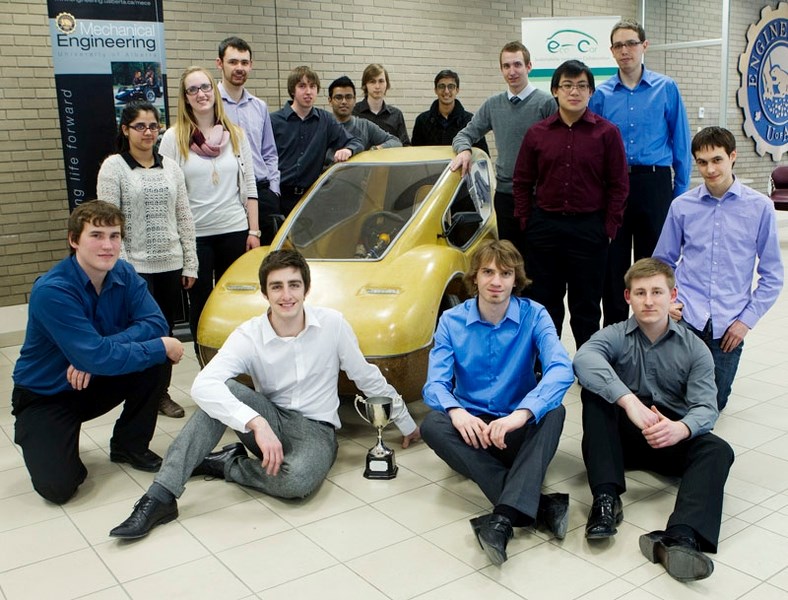A University of Alberta team has unveiled a new car it hopes will show the world that zero-emission transportation is possible.
About 20 members of the U of A’s EcoCar team unveiled their latest zero-emissions electric car Thursday Feb. 28. The car, which is made from biomaterials and powered by hydrogen, will be entered in the international Shell Eco-marathon this April.
The team formed about three years ago when students realized there weren’t many chances for them to work on innovative, sustainable technologies, says Matthew Sponiar, project manager and founding member.
They built their first zero-emission car in 2012 and won second place in the fuel cell category at that year’s Shell Eco-marathon – a race that challenges high-school and post-secondary teams to make the most energy-efficient vehicles possible.
Transportation accounts for about 32 per cent of St. Albert’s greenhouse gas emissions, the City of St. Albert reports, and researchers say we must reduce emissions from transportation to stave off dangerous climate change.
The EcoCar team aims to make zero-emission vehicles, Sponiar says, meaning cars that produce zero greenhouse gas emissions while in operation.
The team’s latest car – its second – meets this goal by using hydrogen fuel cells instead of a gasoline motor. Hydrogen can be produced through electrolysis and run through a membrane system to produce electricity, Sponiar says. If you get the electricity to make the hydrogen from a renewable source, you get zero-emissions fuel for your car.
Hydrogen has a bad rap on account of the Hindenburg disaster, Sponiar says, but it could help commercialize electric vehicles. “Range anxiety is a huge thing that prevents consumers from buying them right now,” he says. Hydrogen-powered cars can go up to 700 kilometres on a single tank, he notes, and refuel much faster than battery-powered ones.
They’ve also used biomaterials in the car’s body to further shrink its carbon footprint, Sponiar says. The top half is made of a Kevlar-cellulose mix, he notes, while the bottom is made from flax and hemp. Flax, hemp and cellulose produce little to no net greenhouse emissions when grown.
“The real nice thing about this stuff is that it’s lightweight,” Sponiar continues. The car’s body is a svelte 20 pounds, which, when combined with a carbon-fibre undercarriage, makes the whole vehicle weigh about 280 – about one-tenth the weight of a 2013 Volkswagen Beetle. Less weight means more fuel efficiency, which should help the team in the Eco-marathon.
The car doesn’t exactly scream off the starting line, says team member Nathan Ryhard, a business student from St. Albert who has driven it. “I raced (the car against) my friend (who was on foot) down the street about 50 metres. I gave him a head start and he won.” It is, however, super-quiet in operation.
The car’s meant for an endurance race, Sponiar says, so there’s no point in making it wicked fast. The team has tricked it out with LED headlights and touch-screen controls, however, and added switches for a “turbo boost,” “ejector seat” and “flux capacitor” to the cockpit. (It doesn’t really have those devices, but it does have cruise control.)
It will also have windshield wipers, says Ryhard, who spent about three months working on them. “We want to build something that’s at least semi-realistic,” he explains, in order to show this technology is roadworthy.
“This isn’t something you’re going to see on the market in the next year or two,” Ryhard continues, as it cost about $80,000 to make, but this car proves that hydrogen could be a viable fuel in the future.
Ryhard says he’s proud that the team has built a working vehicle essentially from scratch. “There’s an incredible sense of satisfaction to driving something that’s not a car you bought, but a car you’ve taken a part in building.”
The team plans to add a silver finish to the car and take it for a test drive later this month, Sponiar says.
The Shell Eco-marathon takes place April 4 through 7 in Houston, Texas.




